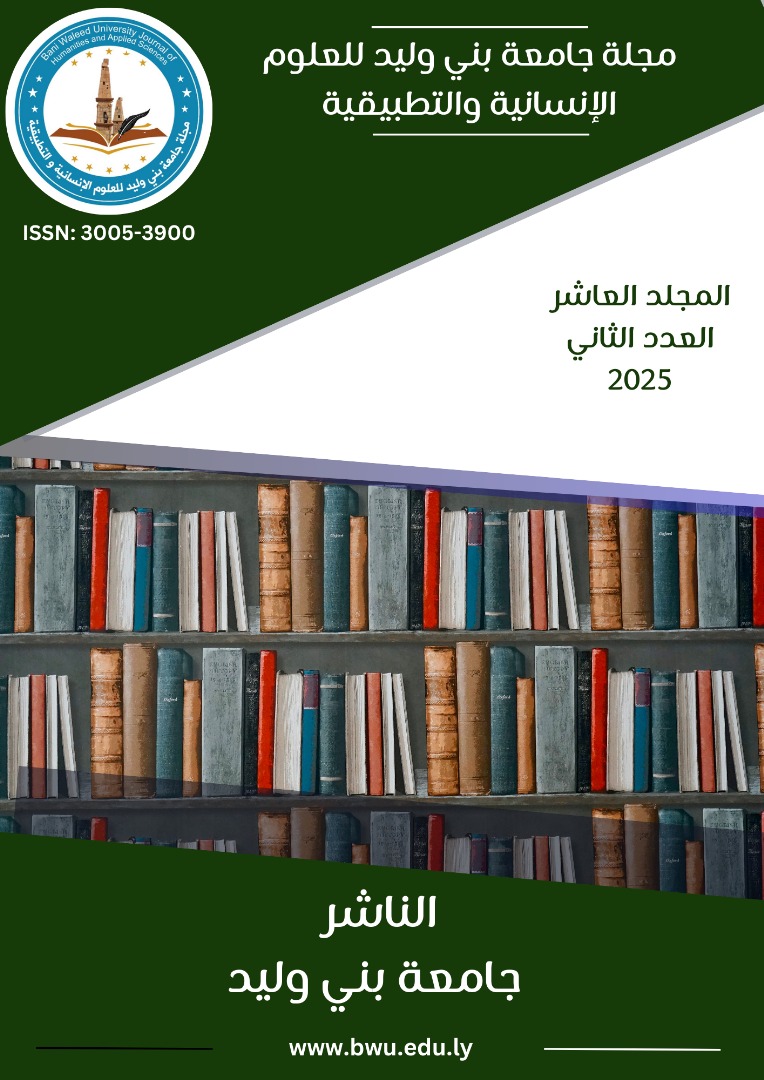أثر المحددات المصرفية الداخلية والخارجية على الاستقرار المالي للمصارف التجارية الليبية
DOI:
https://doi.org/10.58916/jhas.v10i2.738الكلمات المفتاحية:
الاستقرار المالي للمصرف، ملكية المصرف، السيولة، حجم المصرف، الاستقرار السياسي.الملخص
تهدف هذه الدراسة إلى تقصي أثر المحددات المصرفية الداخلية (مثل ملكية المصرف، السيولة، حجم المصرف) والمحددات الخارجية (مثل الاستقرار السياسي) على الاستقرار المالي للمصارف التجارية الليبية، باستخدام بيانات أربعة مصارف هي: مصرف الجمهورية، المصرف التجاري الوطني، مصرف الصحاري، ومصرف التجارة والتنمية، وذلك خلال الفترة من 2010 إلى 2018. أظهرت النتائج أن هناك أثراً إيجابياً لنسبة الملكية المصرفية الخاصة والسيولة وحجم المصرف، والاستقرار السياسي على الاستقرار المالي للمصارف.
التنزيلات
المراجع
Bibliography in Arabic:
First: Academic Articles
- Al-Aswad, Saida, Qad, & Labna. The Impact of Banking Competition on Financial Stability: A Case Study of the Algerian Banking Sector during the Period 2000-2021. (Doctoral Dissertation), University of Kasdi Merbah, Ouargla.
- Zrir, A., & Al-Hamawi, N. (2016). The Relevance of the Z-Score Index. Tishreen University Journal of Scientific Research and Studies, Economic and Legal Sciences Series, 38(1).
- Charsham, Warda. (2022). Towards Directing Banking System Liquidity Management to Support Financial Stability: A Case Study of Algeria during the Period 2000-2019.
- Sadiq, A. M. 2013. Indicators of Political Stability and Their Impact on Economic Growth. Journal of Economic Sciences, 21(2), 123-145.
-Abdulkarim Qandouz, Saed Khalil, and Abdullah Siraj (2022). Determinants of Financial Stability of Arab Banks, Arab Monetary Fund, Training and Capacity Building Institute, Arab Monetary Fund, Abu Dhabi, United Arab Emirates.
-Qasimi, & Salim. Determinants of Financial Stability in the Banking System: A Study of a Sample of Banks in the Kuwaiti Banking System During the Period (2008-2019 AD) (Doctoral Dissertation, University of Kasdi Merbah, Ouargla).
- Marabet, S. & Hanash, H. 2020. Identifying the Factors Affecting Financial Stability in Islamic Banks: An Analytical Study of Ten Islamic Banks During the Period (2010-2018). Journal of Economic and Financial Research, 24(3), 55-72.
- Maysaa Saad Jawad Habbi, The Role of Monetary Policies in Enhancing Banking Stability: An Applied Study of a Sample of Iraqi Banks During the Period (1995-2011) Master's Thesis, published 2013, University of Karbala, College of Administration and Economics, Department of Financial and Banking Sciences. Studies High.
Second: Official Reports
Central Bank of Libya. (January 2025). Central Bank of Libya Reports for the Period 2010-2018: Performance Indicators of Libyan Banks. https://cbl.gov.ly/eco_indicators_category/indicators-of-banking-sector/
References in English:
-A meer Abdul-Mahdi, D., & Bougatef, K. (2024). The relationship between financial stability and credit supply: Evidence from Iraq. Journal of Law and Substantial Development, Volume (12) No1 (2024) https://doi.org/10.55908/sdgs.v12i1.3144
-Adusei, M. (2015). The impact of bank size and funding risk on bank stability. Cogent Economics & Finance, 3(1), 1111489.
-Ali, M., & Puah, C. H. (2018). Does bank size and funding risk effect banks’ stability? A lesson from Pakistan. Global Business Review, 19(5), 1166-1186.
Al-Shboul, M., Maghyereh, A., Hassan, A., & Molyneux, P. (2020). Political risk and bank stability in the Middle East and North Africa region. Pacific-Basin Finance Journal, 60, 101291.
-Asadi, Z., Yavari, K., & Heydari, H. (2020). The study of the effects of liquidity and credit risk on bank stability in Iran using the Z-score index. The Journal of Economic Policy, 12(23), 1-31.
-Badwan, N., Saleh, B., & Hamdan, M. (2024). Factors and determinants affecting banking sector stability: empirical evidence from conventional and Islamic banks listed on the Palestine stock exchange. Journal of Financial Regulation and Compliance, 32(1), 118-150.
-Barros, C. P., & Lima, P. (2021). "The impact of ownership structure on banking stability in Europe." European Journal of Finance, 27(9), 999-1022
-Beck, T., Demirgüç-Kunt, A., & Levine, R. (2006). Bank concentration, competition, and crises: First results. Journal of Banking & Finance, 30, 1581–1603. Retrieved from internal-pdf://154.183.68.116/Bank Concentration.pdf
-Bekaert, G., Harvey, C. R., & Lundblad, C. (2014). Emerging market finance. Journal of Financial Economics, 95(2), 201-226. https://doi.org/10.1016/j.jfineco.2009.11.003
-Bekaert, G., Harvey, C. R., Lundblad, C. T., & Siegel, S. (2014). Political risk spreads. Journal of International Business Studies, 45(4), 471–493.
-Berger, A. N., & Bouwman, C. H. S. (2013). Bank liquidity creation and financial stability. Journal of Financial Intermediation, 22(4), 554-575. https://doi.org/10.1016/j.jfi.2013.01.002
-Bitar, M., Saad, W., & Benlemlih, M. (2016). Bank risk and performance in the MENA region: The importance of capital requirements. Economic Systems, 40, 398–421.
-Borio, C., & Zhu, H. (2022). Capital regulation, risk-taking, and monetary policy: A review of the literature. Journal of Financial Stability, 56, 100974
-Boulanouar, Z., Alqahtani, F., & Hamdi, B. (2021). Bank ownership, institutional quality and financial stability: evidence from the GCC region. Pacific-Basin Finance Journal, 66, 101510.
-Boyd, J. H., & De Nicolo, G. (2005). The theory of bank risk taking and competition revisited. The Journal of Finance, 60(3), 1329–1343.
-Cooray, A. V. (2009). Government expenditure , governance and economic growth. Comparative Economic Studies, 51(3), 401–418.
-Cull, R., Peria, M. M. S. M., & Verrier, J. (2017). Bank ownership: Trends and implications. International Monetary Fund.
-de Haan, J., & Poghosyan, T. (2012). Bank size and stability in the U.S. banking system. Journal of Financial Stability, 8(4), 243-256. https://doi.org/10.1016/j.jfs.2012.06.002
-de Moraes, C. O., & Costa, Á. (2023). Credit behavior and financial stability in an emerging economy. Economic Systems, 47(2), 100999.
- Diab, A., Marie, M., Elgharbawy, A., & Elbendary, I. (2023). The effect of political risk and corporate governance on bank stability in the MENA region: Did the Arab Spring uprisings matter?. Cogent Business & Management, 10(1), 2174207.
-Diamond, D. W., & Dybvig, P. H. (1983). Bank runs, deposit insurance, and liquidity. Journal of Political Economy, 91(3), 401-419. https://doi.org/10.1086/261140
-Farhi, E., & Tirole, J. (2012). Collective moral hazard, maturity mismatch, and systemic bailouts. American Economic Review, 102(1), 60-93. https://doi.org/10.1257/aer.102.1.60
-Ghosh, A. (2015). Banking-industry specific and regional economic determinants of non-performing loans: Evidence from US states. Journal of financial stability, 20, 93-104.
-Guidi, F. (2021). Concentration, competition and financial stability in the South-East Europe banking context. International Review of Economics & Finance, 76, 639-670.
-Gupta, J., & Kashiramka, S. (2020). Financial stability of banks in India: does liquidity creation matter?. Pacific-Basin Finance Journal, 64, 101439.
-Iannotta, G., Nocera, G., & Sironi, A. (2013). The impact of government ownership on bank risk. Journal of Financial intermediation, 22(2), 152-176.
-International Bank for Reconstruction and Development / the World Bank. (2024). Libya economic monitor: Stabilizing growth and boosting productivity. International Bank for Reconstruction and Development / the World Bank.
https://www.worldbank.org/en/country/libya
-Jadah, H. M., Mohammed, N. H., Hasan, M., & Adeniran, A. O. (2020). The impact of the political instability on bank’s performance: evidence from Iraq. Iraqi Journal for Administrative Sciences, 16(65), 224-240.
-Kaur, M., & Kaur, M. (2025). Determinants of banking stability in India. The Bottom Line, 38(1), 49-70.
-Liu, Y., Brahma, S. and Boateng, A. (2020), "Impact of ownership structure and ownership concentration on credit risk of Chinese commercial banks", International Journal of Managerial Finance, Vol. 16 No. 2, pp. 253-272. https://doi.org/10.1108/IJMF-03-2019-0094
-Markussen, T. (2006). US politics and World Bank IDA-lending. The Journal of Development Studies, 42(5)(May), 772–794.
-Minsky, H. P. (1977). A Theory of Systemic Fragility. In The Political Economy of Financial Crises (pp. 138-151). Cambridge University Press.
-Nabil, M. (2024). The Effect of Political Risk on Financial Stability in MENA Region. International Journal of Economics and Finance, 16(10), 1-82.
-Nguyen, T. T., & Pham, D. T. (2022). "Ownership concentration and bank risk in emerging markets." Journal of International Financial Markets, Institutions & Money, 75, 101400.
- Panizza, U. (2024). Bank ownership around the world. Journal of Banking & Finance, 166, 107255.
-Royston, P. (1991). Estimating departure from normality. Statistics in medicine, 10(8), 1283-1293.
-Shim, I. (2019). The impact of liquidity management on bank stability during financial crises: Evidence from emerging markets. Journal of International Financial Markets, 29(5), 143-162. https://doi.org/10.1016/j.intfin.2019.03.004igi
-Stein, J. C. (2013). Overheating in credit markets: Origins, measurement, and policy responses. The Economic Journal, 123(573), 1-23. https://doi.org/10.1111/ecoj.12039
-Stiglitz, J. E. (1993). Privatization and the role of the state in financial systems. Journal of Economic Perspectives, 7(2), 13-28. https://doi.org/10.1257/jep.7.2.1
-Sudarto, S., Adawiyah, W. R., Najmudin, N., & Jati, D. P. (2025). The Impact of Ownership and Financial Stability on Bank Liquidity Creation. Studia Universitatis Vasile Goldiș Arad, Seria Științe Economice, 35(1), 30-48.
-Sujud,H.(2023).The impact of Internal Finance Sources in Achieving Financial Stability An analysisof a sample of commercial banks registered on the Iraq Stock exchange from 2020 to 2019 .Heyam sujud Zaid Ghaniam Shakir Baghdadi.
-Thakor, A. V. (2014). Bank Capital and Financial Stability: An Economic Trade-Off or a Faustian Bargain? Annu. Rev. Financ. Econ., 6(1), 185–223.
-Uhde, A., & Heimeshoff, U. (2009). The concentration-fragility hypothesis and consolidation in the banking industry. Journal of Banking & Finance, 33(7), 1299-1311.
-Wackerly, D., Mendenhall, W., & Scheaffer, R. L. (2014). Mathematical Statistics with Applications. Belmont: Cengage Learning.
-Wang, Y., Song, G., & Lu, Y. (2025). Geopolitical risk, bank regulation, and systemic risk: A cross-country analysis. Finance Research Letters, 106893.
-World Bank (2024, February) Political Stability and Absence of violence/Terrorism: Percentile Rank-Libya. (http://data.worldbank.org/indicator/PV.PER.RNK?locations=LY













